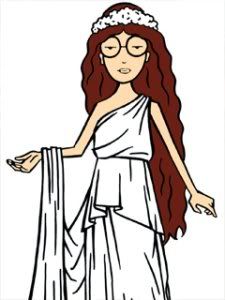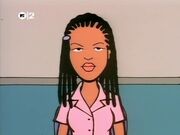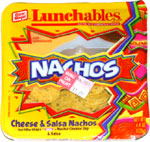Hearken back, if you will, to a time when MTV's original programming budget could afford more than the middle school dropout scriptwriters they currently employ to pen Date My Mom and A Shot of Love with Tila Tequila. A time when intelligent sardonic cartoons could still capture the imagination of a preteen audience not yet contaminated by the likes of High School Musical. A time when a contemptuous misanthrope could hold spotlight rather than be banished to the supporting character category.
And if you didn't quite see yourself as a Daria, well, there was always Quinn.
Daria Promo
The characters in Daria ran the social gamut in a manner of sharp satire rarely found in teen-directed television. This was no Saved by the Bell. No, Daria told it like it was; humorously and critically chronicling the vast teenage wasteland of suburbia. It's rare that such an abrasive character can be so likable, but the writers seemed to strike that perfect balance between edgy and observant. Sure, Daria wasn't all rainbows and sunshine, but she was complex and interesting. Not to mention that relating to her made us feel smart.
Yes, Daria Morgendorffer was of a rare breed. It's odd to think that such a profound and well-conceived character was spun off of such an utterly idiotic show as Beavis and Butthead, but so it was. The Daria sense of humor was fully distinct from the crude, if sometimes admittedly funny juvenile style of Beavis and Butthead.
Daria...from humble beginnings
Daria and her peers were developed in an intelligent way that had eluded their show of origin. The show mainly utilized Daria's derisive eye and provided us with endless satirical jabs at our own high school experience. Her distinct outsider status gave us all an opportunity to pretend for a brief moment that we did not occasionally shamefully see ourselves in the mainstream peers that she so disparaged.
Let's explore our quirky Lawndale cast:
Our Hero
 Daria Morgendorffer, sarcastic extraordinaire and our eponymous hero. Her deadpan monotone packed a lot of punch into her exceedingly judgmental and smart-alecky comments. She met her best friend Jane in self-esteem enhancement class, if that provides any clue as to how she was perceived by others. She was cynical, opinionated, judgmental, and somewhat of a misfit, but there was something in her that was distinctly relatable nonetheless. The beauty of Daria was that even the most teenyboppery among us had some vague experience with teenage angst, though likely not on a Daria-level. As if by magic, the Daria creators were able to draw out (excuse the cartooning pun) that collective part of our adolescent selves who felt ill-at-ease in our orderly surroundings and make light of it.
Daria Morgendorffer, sarcastic extraordinaire and our eponymous hero. Her deadpan monotone packed a lot of punch into her exceedingly judgmental and smart-alecky comments. She met her best friend Jane in self-esteem enhancement class, if that provides any clue as to how she was perceived by others. She was cynical, opinionated, judgmental, and somewhat of a misfit, but there was something in her that was distinctly relatable nonetheless. The beauty of Daria was that even the most teenyboppery among us had some vague experience with teenage angst, though likely not on a Daria-level. As if by magic, the Daria creators were able to draw out (excuse the cartooning pun) that collective part of our adolescent selves who felt ill-at-ease in our orderly surroundings and make light of it.The Trusty Sidekick

Jane Lane, Daria's rhyming-monikered partner in crime. Jane was a burgeoning artiste, favoring the odd and unusual in sync with her favorite TV show, "Sick Sad World." Her parents are frighteningly free-spirited, frequently leaving her and her older brother home alone for indeterminate periods of time to raise themselves as they saw fit. Jane had a comparable worldview to Daria, but was somewhat more relenting with her judgment of others and occasionally exhibited a weakness for the mainstream.
The Unrequited Crush

Tom Sloane, Jane's former boyfriend and all-around likable wealthy snob. Unlike most other teen programs, Daria admirably did not eclipse this boyfriend switcharoo plot line in a single or two-part Blossom-style "Very Special Episode." Rather, the story arc of the tension between Jane and Daria over this clear case of boyfriend stealage was built over an entire season. In the end, Daria was likely just too awkward to maintain a steady relationship, though there was a hilarious after-school-special-esque "should-I-or-shouldn't-I" episode about Daria contemplating the loss of her virginity.
Trent Lane, Jane's brother and equally monotone misguided punk rocker in the band Mystik Spiral. Convinces Daria to pierce her belly button. Obviously bad news.
Helen and Jake Morgendorffer, hilariously overdrawn caricatures but well-intentioned parents nonetheless. Helen was a former-hippie-cum-high-powered attorney and was generally clueless about the lives of her daughters. Jake was a repressed stressball marketing consultant known for his ridiculous rants about the light childhood trauma of imposed military school. Helen and Jake would often spit out one another's names as if they were insults in a relatable if somewhat tragic way. These two were also known for occasionally getting freaky. It was relatively disturbing, if admittedly a tad sweet.
The Bubble-Headed Sister


Quinn Morgandorffer, Daria's ray of sunshine and spectacularly vain and materialistic lil' sis. You were never supposed to admit that Quinn was your favorite character in the face of Daria's more subtle humor and charm, but I must admit I was quite taken by Quinn. You wanted to despise her brazen superficiality, but there was something deep within her self-delusion and self-importance that was oddly appealing. If you could bizzaro-ize Daria exactly, Quinn would be the result. But in her own way, she was sort of cute, and not just because she constantly proclaimed herself to be so.
The Fashion Club
 Quinn's ultra-superficial clique; Sandi, Stacey, and Tiffany, who possessed as a group probably my favorite voicework on any animated characters, ever. Sandi, the slowed-down-Romy-from-Romy-and-Michelle voice whose tyrannical leadership of the Fashion Club and constant rivalry with Quinn was a never-ceasing divisive issue. Born-follower Stacey, who probably should have been the one sent to self-esteem class for her unceasing agreement with everything ever said by anyone. Tiffany, who spoke so slowly you could knit a scarf in the time it took her to construct a sentence. Priceless. If you could have put a price on it, though, it's fairly certain these girls would have bought it.
Quinn's ultra-superficial clique; Sandi, Stacey, and Tiffany, who possessed as a group probably my favorite voicework on any animated characters, ever. Sandi, the slowed-down-Romy-from-Romy-and-Michelle voice whose tyrannical leadership of the Fashion Club and constant rivalry with Quinn was a never-ceasing divisive issue. Born-follower Stacey, who probably should have been the one sent to self-esteem class for her unceasing agreement with everything ever said by anyone. Tiffany, who spoke so slowly you could knit a scarf in the time it took her to construct a sentence. Priceless. If you could have put a price on it, though, it's fairly certain these girls would have bought it.
Joey, Jeffy, and Jamie. All willing to drop anything to attend to Quinn's every whim. Their devotion and attention to detail was certainly admirable, though possibly a bit creepy. Quinn's ultra-superficial clique; Sandi, Stacey, and Tiffany, who possessed as a group probably my favorite voicework on any animated characters, ever. Sandi, the slowed-down-Romy-from-Romy-and-Michelle voice whose tyrannical leadership of the Fashion Club and constant rivalry with Quinn was a never-ceasing divisive issue. Born-follower Stacey, who probably should have been the one sent to self-esteem class for her unceasing agreement with everything ever said by anyone. Tiffany, who spoke so slowly you could knit a scarf in the time it took her to construct a sentence. Priceless. If you could have put a price on it, though, it's fairly certain these girls would have bought it.
Quinn's ultra-superficial clique; Sandi, Stacey, and Tiffany, who possessed as a group probably my favorite voicework on any animated characters, ever. Sandi, the slowed-down-Romy-from-Romy-and-Michelle voice whose tyrannical leadership of the Fashion Club and constant rivalry with Quinn was a never-ceasing divisive issue. Born-follower Stacey, who probably should have been the one sent to self-esteem class for her unceasing agreement with everything ever said by anyone. Tiffany, who spoke so slowly you could knit a scarf in the time it took her to construct a sentence. Priceless. If you could have put a price on it, though, it's fairly certain these girls would have bought it.Brittany and Kevin, dumb as rocks and constantly making out in the hallway. Need I say more?
Jodi Landon and Michael "Don't Call Me Mack-Daddy" Mackenzie; the sole two black students at Lawndale High. Overachieving and sometimes a tad bitter about their ignorant classmates, but generally amiable.
Lawndale High had a distinct knack for attracting faculty of the sanitarium-escapee variety. This ragtag gang of educators included an overly flirtatious bitter divorcee science teacher, the prone-to-shouting perpetually eye-poppingly angry history teacher, Stuart-Smalley-esque English teacher, and budget-hungry principal. Sure, there were a few normal ones in the bunch, but overall these teachers had a certain quality that made us wonder who let them work with children in the first place. We can only image it was part of some sort of work-release program.
As a burgeoning adolescent sarcastic, I too fancied myself some variety of Daria. The fact that I bought a ring bearing her sacred image at the Viacom store in New York City is a clear testament to my Quinn-rivaling lack of irony. This, however, reflected the beauty of Daria. It could be both a biting social commentary and successful commercial enterprise. They even shamelessly exercised some cute if somewhat tired gimmicks like musical episodes and full-length TV movies. The show differentiated itself from others, however, with its own unique brand of humor and distinctly un-MTV-esque quality. If you've ever sat through an episode of Parental Control, you know that's a good thing.
It also helped that the show didn't take itself too seriously, as many teen shows of the time were wont to do. Daria maintained a wonderfully tongue-in-cheek tone that created a cartoon world in which nothing was sacred, or at least nothing was safe from the show's critical lens. The wit was dry and sharp and utterly unapologetic. Better yet, the show's credits ended with "alter-ego" drawings of the main characters dressed as famous figures. What's not to like?



If you never got into it or simply can't seem to conjure up the memories, I've included a handy full episode (Season 3, episode 6, "It Happened One Nut") to revive what I can only hope will be your undying and forever devoted love to a once-great MTV show. If this doesn't convince you to join the fight for DVD release, I'm not sure what will:
Check it out:
Secret Stash of multi-part full eps on YouTube
Outpost Daria



















